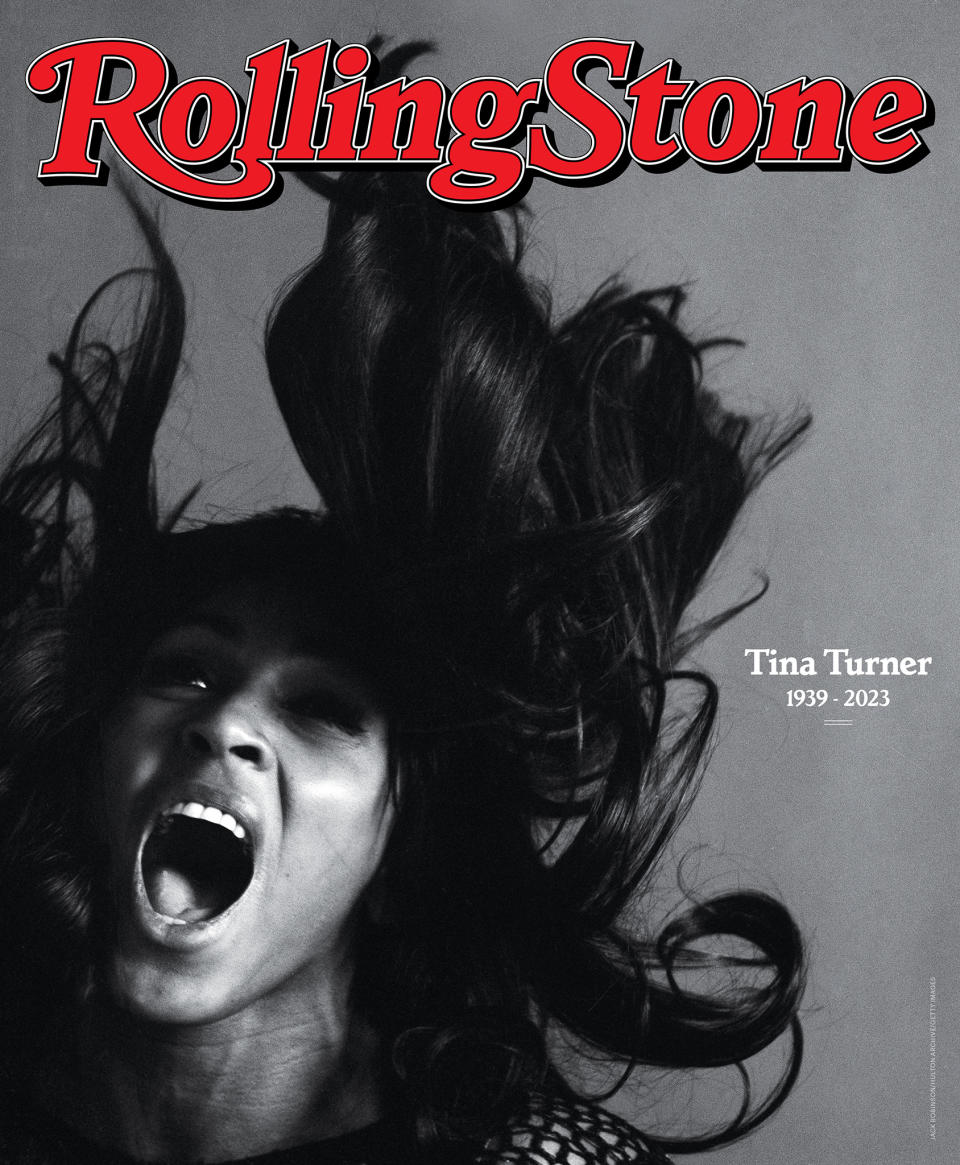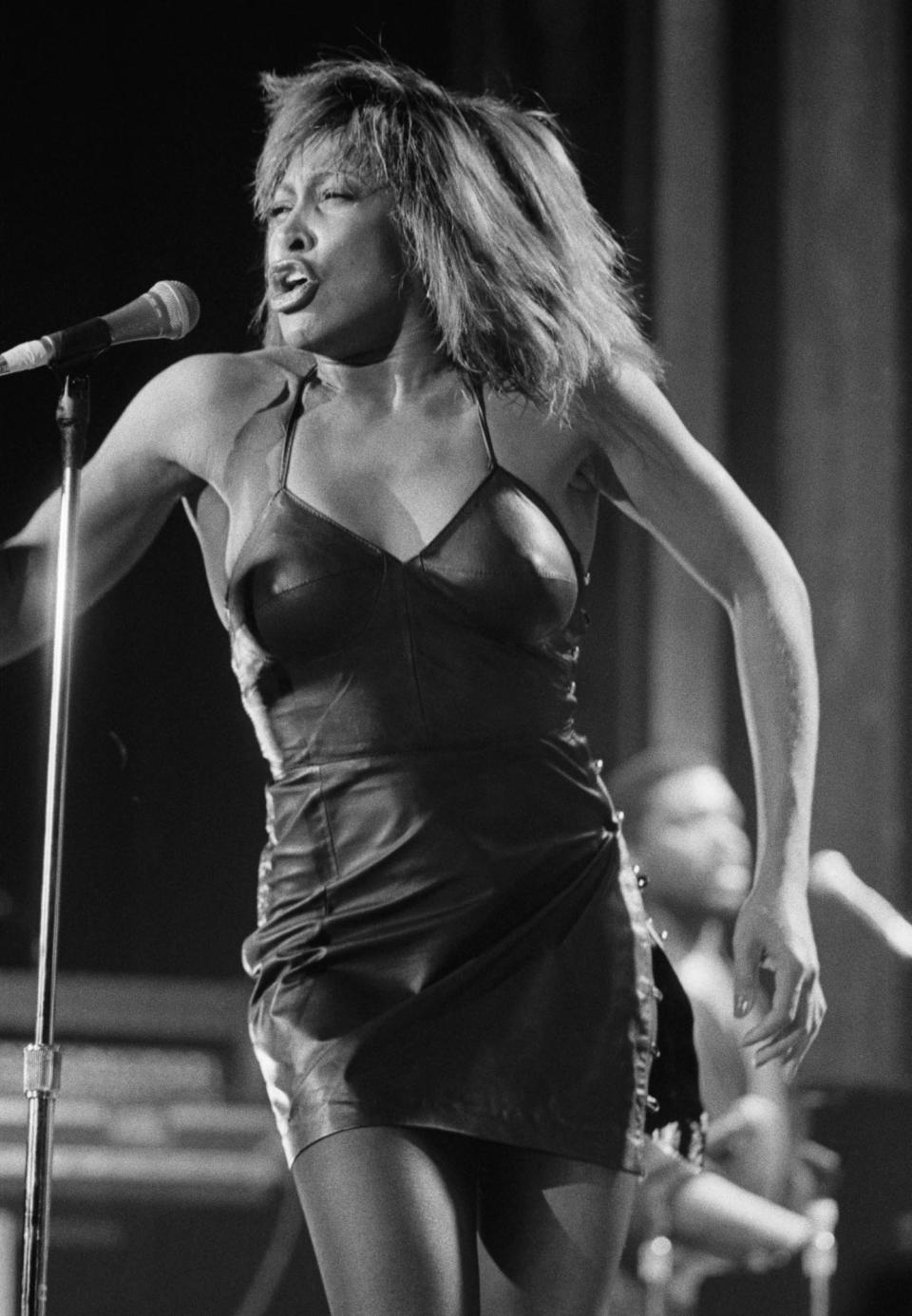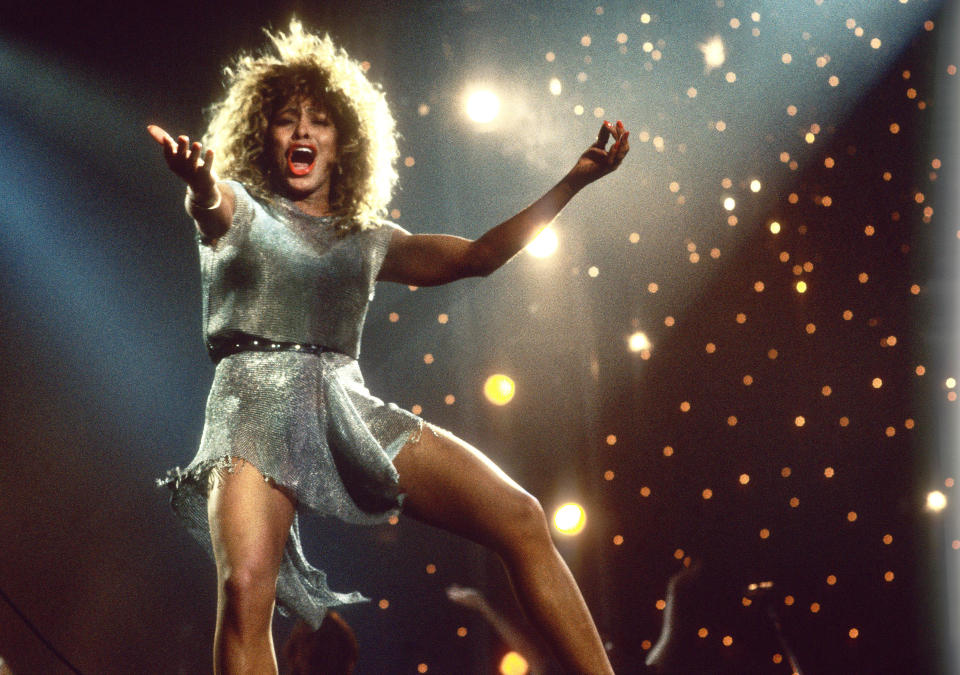How Tina Turner Pulled Off Pop’s Greatest Comeback

- Oops!Something went wrong.Please try again later.
- Oops!Something went wrong.Please try again later.
One day in London’s Kensington district in 1983, Tina Turner’s resurrection finally appeared within reach. The prior decade had been one of stage-shaking triumphs, personal nightmares, various degrees of mortification, and now, a chance at possible redemption. But as musician and producer Martyn Ware soon learned, Turner’s past was never in the rearview mirror — and on that day, it was terrifyingly in her face.
The previous year, Turner had sung on an edgy, pulsating remake of the Temptations hit “Ball of Confusion,” and now Ware — who had co-helmed that track, had co-founded the Human League, and was a member of Heaven 17 — was meeting with her to map out another collaboration. Arriving at what he recalls as “a beautiful kind of mansion” where Turner was staying, Ware took note of security guards outside. To his shock, Ware says, he was told that Turner’s ex-husband, Ike, who had previously served 30 days for drug possession and wasn’t averse to shooting at the newspaper-delivery guy or making threats on his wife’s life, was in the city and calling; he was apparently trying to scale the walls of the building to demand money from Tina. “It was still going on then,” Ware says. “And I thought, ‘Tina is having to deal with this on a continuous basis.’ She did everything with such grace, poise, and good humor. She must have been hurting underneath it all.”
More from Rolling Stone
Let's Shop: The Best Gift Ideas Any David Bowie Superfan Will Appreciate (Yourself Included)
Beyoncé Continues Honoring Tina Turner on Tour With 'River Deep - Mountain High' Cover

Ultimately, Turner and Ware decided to make over Al Green’s “Let’s Stay Together.” The track would be the next step on the road to Private Dancer, the 1984 album that would reestablish Turner as a musical force and a public symbol for overcoming crushing personal adversity. “I think people actually go and see her not for the songs necessarily — they go to see her for what she represents,” her friend David Bowie would later say. “The baggage of her past travels with her, and they’re going to see somebody who like a phoenix from the ashes has risen.… She’s certainly been through far worse than many of us have been through.”
Given how much she was embraced by old admirers, the MTV generation, and the industry — the holy-grail triumvirate in the music business at the time — Turner’s comeback should have been a cakewalk. Once the public learned what she’d endured with Ike, by way of a People interview in 1981, there were few pop stars more beloved. But the jarring reemergence of her ex-husband on an otherwise productive day in England would be far from the only hurdle in one of pop’s most unexpected returns. Even then, with the world cheering her on, Turner’s second act was never a given. At any moment, it could have been derailed by ageism, skeptics who wondered if she could make it on her own, music never released in her home country, and at least one racist music executive. Triggered in part by memories of life with Ike, she almost tripped herself up by not wanting to revisit the music that had made her a star to begin with. Only a series of happy accidents, combined with her unbridled belief in herself, would save her.

BY THE START of the Eighties, it was hard to imagine an even remotely bright future for Tina Turner. For many years, she’d been a star, fronting a band with Ike that raced like a locomotive through the pop landscape. Ann Bullock had wanted to be a nurse, but after meeting Ike and his band, the Kings of Rhythm, at a nightclub in St. Louis, Bullock was reborn, eventually renamed by her soon-to-be-husband as Tina Turner.
The two had a handful of R&B hits before crossing over to the rock world, thanks in part to opening for the Rolling Stones and remaking rock hits like “Proud Mary” and “Honky Tonk Women” in their own brassy, soul-revival style. Ike may have been the guitarist, boss, and bandleader, but all eyes were on his wife, who had the throaty, sensual delivery of a great gospel or blues singer and uninhibited dance moves unlike almost anything seen in pop. Her version of Otis Redding’s “I’ve Been Loving You Too Long,” which found her stroking her microphone, was undeniably erotic, and Turner herself was arguably the first major Black female rock star.
At the time, few knew the horrors of her life offstage and in studios with her abusive and womanizing husband. “Ike was beating me with phones, with shoes, with the hangers,” she relayed in her first memoir, I, Tina. “Choking me, punching me — it wasn’t just slapping anymore.” Right before one show, he punched her so hard that he broke her jaw, and she had to still go onstage and sing. In 1976, at age 36, she left him and found herself raising four children while drowning in an ocean of debt. To earn a living, she took any work she could: on cheesy TV variety shows and in Vegas, where she resorted to covers of dance hits like “Disco Inferno”; during one dinnertime show, she accidentally dropped her mic into a customer’s steak. “Suddenly the booking agents didn’t think I had the ability to work without Ike,” she said. “It was like starting over again.”
Turner’s relaunch began just as the Eighties began — and in the first of many such examples, it almost failed. R&B and disco were out, New Wave was in, and Turner again was musically adrift. Roger Davies, a young Australian manager, decided to see one of her regular gigs: two shows a night at the Venetian Room at the Fairmont Hotel in San Francisco in 1980. At first, Davies was underwhelmed by the garishness of her show, which included Turner in gaudy Bob Mackie dresses, four backup dancers, and covers of standards like “Fever.” Reviewing her opening night, the Oakland Tribune wrote that Turner’s show was “geared to the visiting conventioneer crowd.”
But luckily for Turner, Davies stayed for the wilder second set. “People were standing on tables,” he recalled in I, Tina. “The chandeliers were shaking.” Before long, and with Turner’s consent, Davies fired two of her dancers and hired new musicians. “She wanted to rock,” says drummer Jack Bruno, one of the new recruits. “There were other tunes she would bring and put her touch on, which usually meant faster tempos. That was her signature thing, how she made songs her own.” To save money, the new musicians were outfitted in matching black karate suits (instead of the more costly tuxedos of the previous lineup). “Ike was the musician, the bandleader, the director, the business manager,” Turner said in 1981. “Now, that falls on me. That part is hard. I must make decisions I didn’t have to make before.”
As she told Rolling Stone at the time, “I want to get back into the rock of it!” Turner was still without a record deal and longed to be on par with the biggest bands of the time. “She wanted to be up there with the Stones and be mainstream and have hits of her own,” says Ann Behringer, one of her backup dancers and singers during this period — and with Davies’ help, that goal began taking shape. Rod Stewart invited her to join him on Saturday Night Live, and Turner opened for the Stones in New Jersey.

During those early days of her rebirth, Turner still packed her set with Ike-era singles like “Proud Mary” and “River Deep, Mountain High.” But she often opened with a new addition to her repertoire — her own version of Stewart’s sleazy deep cut “Foolish Behavior,” renamed “Kill His Wife.” The lyrics alone were startling: “Why I wanna kill my wife?/I have this urge to take her life/Been planning for years to get rid of her/Not divorce, I really do mean to kill her.” During the instrumental break, Turner took the intensity one step further by grabbing a shocking prop — a noose, which she twirled around like a lasso.
Bruno felt that Turner was going for something stagey. “I’m not sure about her thought process, but she liked the theatrics of it,” he says. “The audience was politely applauding, but they didn’t know what to think.” Again, few knew what Turner was coping with after she left Ike — death threats that made her fear for her life so much that she briefly carried a .38 and hired bodyguards. During one of her sets at the Fairmont, Ike arrived with an entourage. “She got super anxious,” Behringer says, “but was a professional and acted like everything was fine.” Turner never commented on the noose, and it didn’t remain in her show long. But its disquieting imagery aside, that rage and defiance was the first hint of the way Turner would become a heroine to women who’d suffered from domestic violence and were looking for a way to survive and reset their lives.
STARTING WITH DAVIES sticking around for her Fairmont show, the happy-accident aspect of Turner’s return continued with James Brown. In 1982, British Electric Foundation — a partnership between Ware and Ian Craig Marsh — was working on a collection of synthed-up covers of songs from the Sixties and Seventies. The duo had enlisted Brown to front their remake of “Ball of Confusion.” But at the last minute, negotiations with Brown fell through, they say, and suddenly the producers were left with a backing track and no singer.
To Turner’s good fortune, the career-salvaging coincidences continued. In the offices of Virgin Records in London, Ware was bemoaning the fate of his project when Ken Berry, one of the founders of the label, walked by and overheard his predicament. Berry mentioned his friend Tina Turner: Maybe she’d be available? Ware had just seen her play in London and was reminded of the power of her voice and persona. “I was blown away by her talent and energy,” he recalls. “And I thought, ‘Well, if anybody can do it, Tina could.’”
I was blown away by her talent. I thought, ‘if anybody could do it, Tina could.’
When Ware offered Turner and Davies plane tickets to London, they accepted — but the first phase of her comeback almost fell through. When she learned that the song in question was “Ball of Confusion,” she “freaked out,” Davies later recalled in I, Tina. “She was so afraid of being put back into any kind of category like ‘oldies’ or ‘R&B.’” (In Ware’s memory, Turner had rehearsed the song before, but may have been unnerved by the fact that the “band” amounted to a bank of synthesizers.) Eventually, Turner went along with the idea, cutting the vocal in one day. Whether the song and era evoked memories of Ike was unclear, but she seemed ready to move on. “That was quite tricky, to sing that song — it sounds like there’s more than one voice on it,” Turner said afterward to Ware. “And I’m saying, ‘It’s the Temptations, Tina,’” he recalls. “She said, ‘Who are they?’ My theory is that she turned her back on soul music. It’s partly [Ike] and partly that she felt more connection with the world of rock & roll.”
In another setback, “Ball of Confusion” was only released in Europe. But the song’s ominous, herky-jerky throb was a universe removed from the soul grooves she had thrown down with Ike. In that way, it was a success, announcing to the world that a new Tina Turner had arrived. In its wake, Capitol Records expressed interest in her, and she and John Carter, an A&R man who’d become a Turner champion, began laying down tracks.
A Turner revival now seemed possible — until, again, it almost wasn’t. In 1983, Capitol replaced its team with new management, who began questioning some of the projects in the works. In an infamous comment made to Carter, first reported on PopMatters in 2009, an unnamed executive informed Davies that he was dropping Turner from the label’s roster, slurring her as an “old n—-r douchebag.” (After audio of that comment was included in the 2021 documentary Tina, Capitol issued a statement saying the company was “under different ownership and management, and we’re only now learning of those reprehensible and appalling comments.”) Dropping to his knees in a meeting, Carter (as he told PopMatters) informed the boss that he wouldn’t leave the room until he called Davies to say he’d made “a mistake.” Eventually, the executive begrudgingly agreed to reverse his decision, while adding that the company would barely lift a finger to promote an album. Her new music would be dead on arrival.

To modernize her sound and image, Turner had dragged her repertoire into the Eighties, too, incorporating Don Henley’s “Dirty Laundry” and Bowie’s “Cat People (Putting Out Fire)” into her set. The Bowie association would lead to another pivotal, if accidental, moment in her life. In January 1983, Bowie was in New York to sign with EMI, and was asked what he was planning to do that evening. To the surprise of the staff, he announced he was going to see his favorite singer: Turner. Thanks to that endorsement, Davies unexpectedly received a request for more than 60 free tickets to the show, all for employees of the label. “I became infinitely more interesting to them after I got David’s seal of approval,” Turner said. “I didn’t know any of this until later.”
That night, Turner was booked into the Ritz, an art-deco club in the East Village that, reflecting Turner’s own transformation, couldn’t have been further removed from Vegas Strip ballrooms. When Turner first played the club, in 1981, Mick Jagger, Robert De Niro, Diana Ross, and Susan Sarandon were all in attendance. Now, thanks to “Ball of Confusion,” Turner’s return engagement in the first month of 1983 had another stellar guest list in the house — Bowie, Keith Richards, and tennis bad boy John McEnroe.
Dressed for part of the show in a black-leather minidress, Turner was up for the challenge: Her intro to “Proud Mary” was even more suggestive than usual, her renditions of the Bowie and Henley songs burned down the house, and a slow, simmering version of the Beatles’ “Help!” added a touch of real-life gravitas. At one point, Behringer turned toward the balcony that wrapped around most of the venue to see Turner’s all-star fans cheering her on. “You look up and there’s David Bowie and all these people, and it was like, ‘Whoa,’” she says. “They were all rooting for her 100 percent. They all idolized her.”
After the show, everyone gathered in the small VIP room off the office of club owner Jerry Brandt, which held 10 people tops. Turner, who always insisted she didn’t drink or do drugs, playfully grabbed a champagne bottle and, in one of many flirty moments between them, pretended to pour it into Bowie’s mouth. According to photographer Bob Gruen, who was in the room, Bowie played along, although he was worried the champagne would spill on his clothes. The festivities carried on at Keith Richards’ room at the Plaza hotel, where Richards played piano, and food and alcohol were wheeled in until dawn. “Everyone was happy for Tina that night,” says Gruen. “She showed she could do it by herself; it didn’t have to be ‘Ike and Tina.’” As Turner later wrote, “For me, that night at the Ritz was the equivalent of going to the ball (minus the part about Prince Charming) because it changed my life dramatically.”

With that, work on what would become Private Dancer began, starting with Turner returning to London for another collaboration with Ware and Marsh. And again, Turner was less than enthralled with the songs they suggested, which included “Let’s Stay Together.” “Aren’t you guys into any rock & roll?” she asked. Again, Turner relented: As she admitted, “I had a crush on someone back in America,” so the song appealed to her. As with “Ball of Confusion,” her simmering take on the Al Green classic was initially not available in the states. Only after it had become a hit in the U.K. did Capitol deign to release it at home.
Still, nothing was guaranteed. Drummer Bruno thought Turner’s future so uncertain that he left the band. “I’d been doing it for three years, and it never changed,” he says. “We were playing the hotels, and I was like, ‘I’m done. I don’t know if this is going anywhere.’ Just goes to show you how much I knew.” One of his last gigs with her was a McDonald’s convention in Hawaii. (Bruno later rejoined the band after Private Dancer and continued as her drummer for decades.)
But the success of “Let’s Stay Together” finally sent Private Dancer into overdrive, and Davies and Carter scrambled to find producers and songs. One of them, “What’s Love Got to Do With It,” had already been rejected by other big names. Turner herself nearly passed. “I didn’t like it,” Turner said. “I didn’t think it was my style,” also dubbing it “wimpy.” But Davies persevered, and the single, which brought out the weariness and tenderness in Turner’s voice, would be the one that firmly announced to the world that Turner was reborn. It had taken only four years of expectations, crushed hopes, wrong turns, and slurs, but Turner finally arrived, and for good. “The whole thing is about earning your way,” she later wrote in I, Tina, pondering advice to a child, “and you don’t really get there until you earn it.”
Best of Rolling Stone

